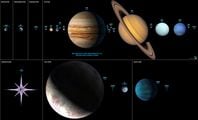Saturn: Difference between revisions
From Halopedia, the Halo wiki
Lord Susto (talk | contribs) (Created page with "{{SeeWikipedia}} {{Planet |name = Saturn<br/>Sol VI |image = |star, position = Sol, VI |moon(s) = 62 |satellite(s)...") |
NightHammer (talk | contribs) No edit summary |
||
| Line 1: | Line 1: | ||
{{ | {{Era|Forerunner|Covenant|Human|UNSC|HCW|Post}} | ||
{{Planet | {{Wikipedia}} | ||
|name | {{Planet infobox | ||
|image | |name=Saturn | ||
|star, position | |image= | ||
|moon(s) | |star, position=[[Sol system|Sol]], VI<ref name="enc295">'''[[Halo Encyclopedia]]''', ''page 295'' (2011 edition)</ref> | ||
|moon(s)=62 | |||
|diameter | |diameter={{Convert|116464|km|mi}} | ||
|yearlength | |gravity=1.139 G | ||
|atmosphere | |daylength= | ||
| | |yearlength=29.5 [[Earth]]-years | ||
|atmosphere= | |||
|composition=Various gases and ices | |||
|temperature= | |||
|demonym= | |||
|species= | |||
|population= | |||
|date of foundation= | |||
|government= | |||
|technology tier= | |||
|hidec=yes | |||
}} | }} | ||
'''Saturn''' is a planetary gas giant and the second biggest planet in the [[Sol system]]. It is the sixth planet from Sol, after [[Jupiter]].<ref name="enc295"/> | |||
Saturn is considered one of the more visually appearing objects in the Sol system, due to the gas giant's bright, massive system of [[Wikipedia:Planetary ring|planetary rings]]. Saturn's [[natural satellite]]s are not as explored as [[Jupiter]]'s [[Jovian Moons|moons]].<ref name="enc295"/> Its practical uses to the [[UNSC]] are limited, due to Saturn's distance from Sol and the lack of necessity to be colonized, and therefore it is mostly just a tourist destination.<ref>'''Halo Encyclopedia''', ''page 283''</ref> A tourist station called [[Castellaneta]] is positioned in geosynchronous orbit on the "sunny side" of Saturn's outermost ring.<ref>'''[[Halo: New Blood]]''', ''Chapter 5''</ref> | |||
==Gallery== | |||
<gallery> | |||
File:HaloPlanets.jpg|A comparison of Saturn and several other planets | |||
</gallery> | |||
==List of appearances== | ==List of appearances== | ||
Revision as of 16:10, March 16, 2015
| There is more information available on this subject at Saturn on the English Wikipedia. |
| Saturn | |
|---|---|
| Astrographical | |
|
Moon(s): |
62 |
| Physical | |
|
Diameter: |
116,464 kilometres (72,367 mi) |
|
Gravity: |
1.139 G |
|
Length of year: |
29.5 Earth-years |
Saturn is a planetary gas giant and the second biggest planet in the Sol system. It is the sixth planet from Sol, after Jupiter.[1]
Saturn is considered one of the more visually appearing objects in the Sol system, due to the gas giant's bright, massive system of planetary rings. Saturn's natural satellites are not as explored as Jupiter's moons.[1] Its practical uses to the UNSC are limited, due to Saturn's distance from Sol and the lack of necessity to be colonized, and therefore it is mostly just a tourist destination.[2] A tourist station called Castellaneta is positioned in geosynchronous orbit on the "sunny side" of Saturn's outermost ring.[3]
Gallery
List of appearances
- Halo: New Blood (First mentioned)
Sources
- ^ a b Cite error: Invalid
<ref>tag; no text was provided for refs namedenc295 - ^ Halo Encyclopedia, page 283
- ^ Halo: New Blood, Chapter 5
